Unit - 7
Introduction to kinetics of rigid body
Kinematics is the branch of mechanics or simply a part of dynamic analysis which deals with the study or analysis of the motion of the body without considering the forces that causes this motion.
Hence Kinematics only analyses the geometry of the particle or rigid body.
2. Kinetics
Kinetics is the branch of mechanics or simply a part of dynamic analysis which deals with the study of motion of the body by considering the forces that causes this motion.
In other words, kinematics relates with the forces acting on the moving body.
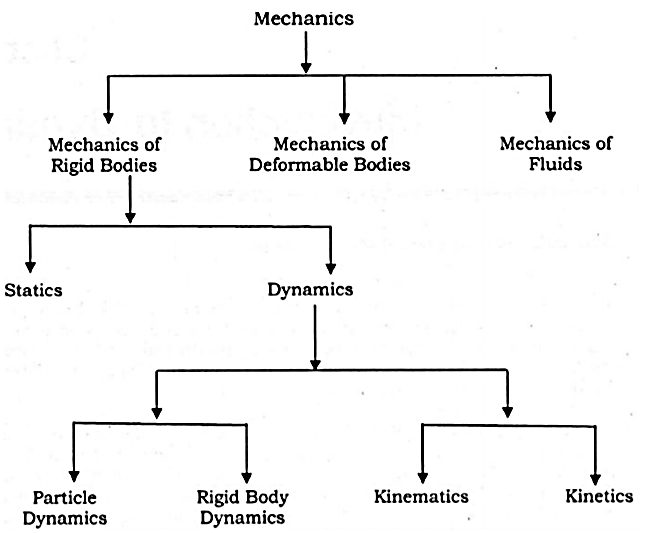
Newton’s second law is the basis for kinetics. It states that when an unbalanced force acts on a particle, the particle will accelerate in the direction of the force with a magnitude that is proportional to the force.
If the mass of the particle is m, Newton’s second law of motion can be given in mathematical form as

When more than one force acts on a particle, the resultant force is defined by a vector summation of all the forces.

In general equation of motion is written as,

A rigid body is an ideal body that does not change its shape when subjected to external forces or couples. The distance between the particles in a rigid body remains same during the motion. Hence, a rigid body can be defined as the group or collection of number of particles at fixed distance from each other.
There are three types of motion of a rigid body
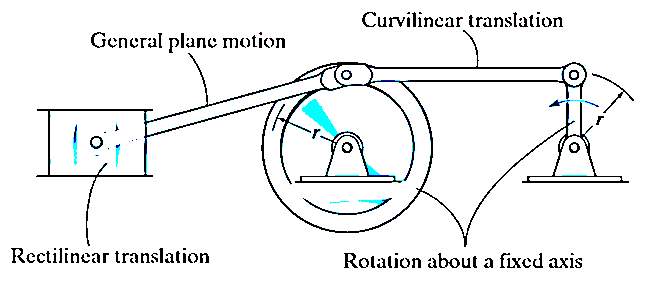
Translation motion
Translation motion occurs when a line (generally axis) in the body remains parallel to its initial orientation throughout the motion.

If the path of motion of any two lines on the rigid body are parallel or are in a straight line, then the translation is termed as rectilinear translation.
If the path of motion of any two lines on the rigid body are along the fixed curve, then the translation is termed as curvilinear translation.
Consider a rigid body that is subjected to translation motion as shown in fig.
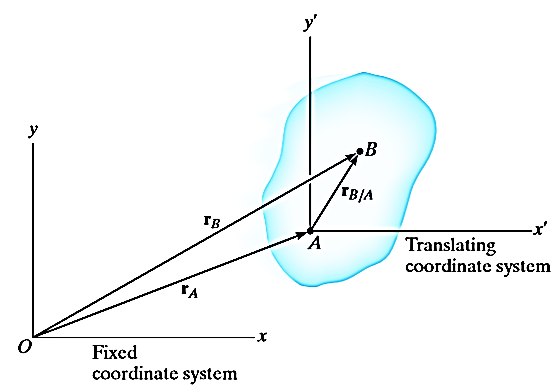
The position of points A and B is defined are defined by the position vectors  and
and  w.r.t the fixed frame x, y.
w.r.t the fixed frame x, y.
Let the translating system is fixed in a body with origin A which is referred to the base point. The position vector of B w.r.t A is denoted by  .
.
By vector addition, we get,


Taking, the first-time derivative of the above equation, we get,

According to the definition of rigid body, the term  is constant
is constant
Hence,

And,  gives the absolute velocities
gives the absolute velocities  and
and  respectively with respect to the fixed frame.
respectively with respect to the fixed frame.
So, we get,

This shows that, for the rigid body in translation motion, the velocity of every particle on the body is same.
Now, taking the time derivative of the velocity equation, it simply yields

Where,  and
and  are the absolute accelerations of points A and B on the rigid body w.r.t fixed frame.
are the absolute accelerations of points A and B on the rigid body w.r.t fixed frame.
This shows that, for the rigid body in translation motion, the velocity and acceleration of every particle on the body is same.
Rotation Motion:
When a rigid body is subjected to the rotation about a fixed axis, as shown in fig below, all the particles of the body, except those which lie on the axis of rotation, move along circular paths whose center lies on the axis of rotation.
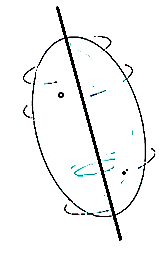
Consider, the point P on the rigid body defined by the position vector r. As the rigid body rotates about the fixed axis, then the point P travels a circular path of radius r with center point O as shown in fig below
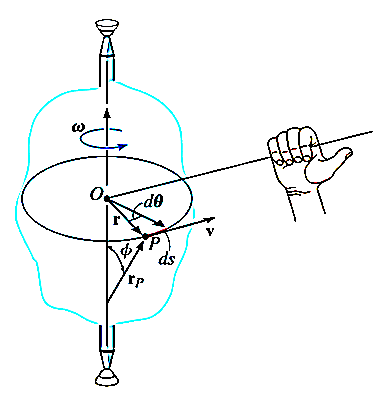
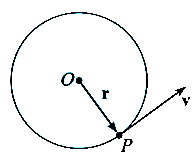
If the body rotates with a differential angular displacement  , then the point P displaces the distance
, then the point P displaces the distance  , which is given by
, which is given by

Differentiating the above equation w.r.t time, we get

The term,  is referred to as the angular velocity
is referred to as the angular velocity  of the rotating body
of the rotating body
And  gives the velocity of point P
gives the velocity of point P 
Hence,

The direction of velocity is tangent to the circular path.
Considering the magnitude and direction, velocity is the cross product of angular velocity and the position vector
Where,  is directed from axis to the point P
is directed from axis to the point P
To find acceleration, differentiate velocity vector w.r.t time

Here, the term  refers to the angular acceleration
refers to the angular acceleration  of the rigid body
of the rigid body
And  is the velocity
is the velocity 
Hence,

Where,  is the tangential acceleration and
is the tangential acceleration and  is normal component of acceleration
is normal component of acceleration
Hence,

Magnitude of both components is given by,


Tangential component refers to the time rate of change of velocity’s magnitude. Hence, if velocity of point P is increasing,  is in same direction of
is in same direction of  , but if velocity of point P is decreasing,
, but if velocity of point P is decreasing,  is in direction opposite to that of
is in direction opposite to that of 
The normal component of acceleration refers to time rate of change of the velocity’s direction. Hence, the direction of the normal component is always from point P towards the center O. Hence it is also called as centripetal acceleration.
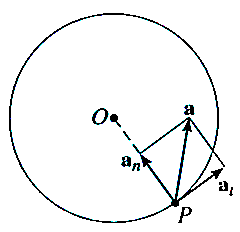
General Plane motion:
General plane motion of a rigid body refers to a combination of translation and rotation motion.
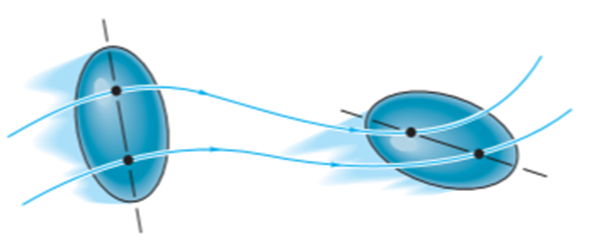
General planar motion refers to the simultaneous rotational and translational motion of a planar body in a 2-D plane.
General planar motion can be fully specified by knowing both the angular rotation of a line fixed in the body and the motion of any point on the body.
These motions can be related by using a rectilinear position coordinate s to locate the point along its path and an angular position coordinate  to specify the orientation of the line. Then these two coordinates are related using the geometry of the problem. The following relation is found.
to specify the orientation of the line. Then these two coordinates are related using the geometry of the problem. The following relation is found.

Differentiating the above equation, gives the relation between velocity  and angular velocity
and angular velocity  .
.
Where,

Then again differentiating, it yields to the relation between acceleration  and angular acceleration
and angular acceleration 
Where,



Consider a plane body P having a non-linear motion relative to another plane body q as shown in figure below.
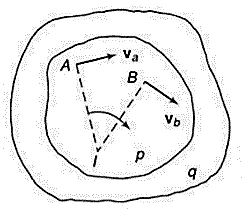
Let the velocities of two points A and B on the plane body P be  and
and  respectively in the direction as shown in figure above.
respectively in the direction as shown in figure above.
The body if in non-linear motion, then at any instant the body can be imagined to be rotating about some point. This point lies on the line perpendicular to the direction of vibration. If we draw perpendicular lines to the direction of velocities at point A and B respectively, then the point of intersection is the point at which the body p is imagined to be rotating. Let this point be 1. Then point 1 is called as instantaneous center of rotation (ICR) for the body p in non-linear motion.
This property of instantaneous center of rotation is true only for an instant and at the next instant, the new point will become the instantaneous point of rotation. This is the reason that this point is not called as center of rotation but instantaneous center of rotation.
ICR is not located at the center of curvature of the path apparently taken by a point of one body relative to other body. In spite of this limitation, ICR is a useful tool for understanding the kinematics of a planar body in non-linear motion or in general plane motion.
If the intersection of the perpendicular lines lies outside planar body, then ICR will also lie outside of the body. If the direction of velocities are parallel to each other, then the perpendicular lines will also be parallel to each other and hence, these lines do not intersect. In such cases, ICR lies at infinity.
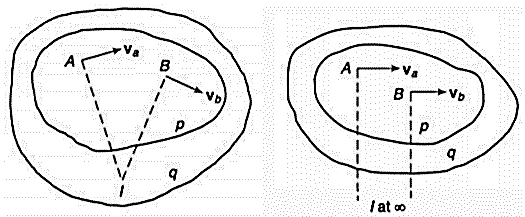
The velocity of the body at any point is proportional to the distance of the point from the ICR. Hence, the velocity of point 1 (ICR) itself is zero, as the distance is zero. This implies that, at ICR, the two bodies p and q are relatively at rest. Means, there is no relative motion at ICR between the two bodies.
Now, consider the body q is in relative motion to the third body r. The relative motion of ICR with respect to third body r would be same irrespective of the point is considered on body p or q.

D'Alembert’s principle provides a method of solving problems of dynamics by developing equations of motion in the form of equations of equilibrium.
In simple words, D’Alembert’s principle is just the principle of virtual work with the inertial forces added to the list of forces that do work.
Consider a body in general plane motion as shown in figure below.

Consider this body is at rest and let  be the resultant external forces acting on a rigid body and
be the resultant external forces acting on a rigid body and  be the virtual displacement of the body is s direction.
be the virtual displacement of the body is s direction.
Then according to principle of virtual work,

This method is used for solving statics problems. In statics problems there are no accelerations.
We can extend this principle of virtual work for solving dynamics problems.
For the system of mass m and resultant acting forces  , according to Newton’s second law of motion,
, according to Newton’s second law of motion,

We can make this dynamics problem look like a statics problem by defining an inertial force given by,

Now, for dynamics problems, principle of virtual work becomes,

As the virtual displacement is same for both the active forces and inertia forces,

This is D’Alembert’s principle used for solving the dynamics problems by using the concept of equilibrium conditions.
The above equation can be written as


Considering the rigid body in general plane motion as shown in figure below:
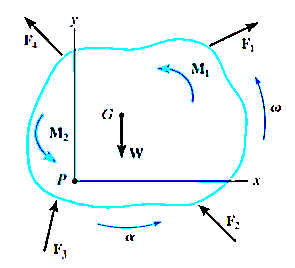
Applying D’Alembert’s principle, three independent scalar equations can be written to describe the general plane motion of a symmetrical rigid body.



These equations are called as equations of motion.
When applying these equations, one should always draw a free-body diagram.
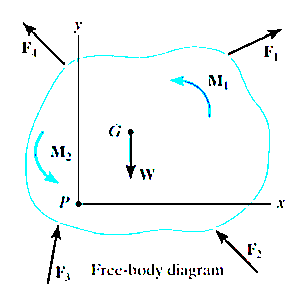
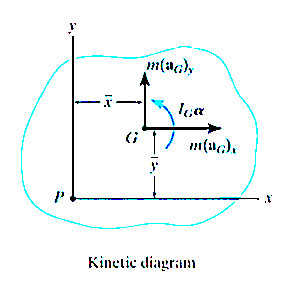
In some problems it may also be helpful to draw the kinetic diagram for the body. This diagram graphically accounts for the terms  ,
,  and
and  .
.
Consider the rigid body as shown in Figure, which is represented here by a slab moving in the inertial x–y reference plane.
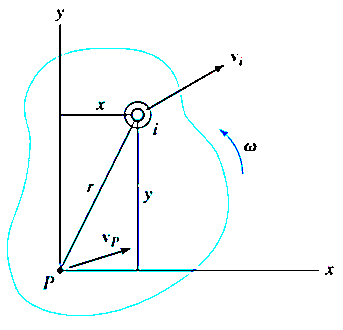
An arbitrary ith particle of the body, having a mass dm, is located a distance r from the arbitrary point P. If at the instant shown the particle has a velocity then the particle’s kinetic energy is

The kinetic energy of the entire body is determined by integrating above equations

Solving above equation when point P coincides with center of mass of the body G, we get

Where,
 = velocity of center of mass or simply velocity of rigid body
= velocity of center of mass or simply velocity of rigid body
 = mass of whole body
= mass of whole body
 = Mass moment of inertia of a body about an axis passing through center of mass G
= Mass moment of inertia of a body about an axis passing through center of mass G
 = angular velocity of a body
= angular velocity of a body
When a rigid body is subjected to general plane motion with an angular velocity  and its mass center has a velocity of
and its mass center has a velocity of  , then kinetic energy is given by
, then kinetic energy is given by

Work by a force for a rigid body
If an external variable force F acts on a body to move the body along the path s with displacement ds, then the work done is given by,

Where,  is the angle between the “tails” of the force and the differential displacement.
is the angle between the “tails” of the force and the differential displacement.
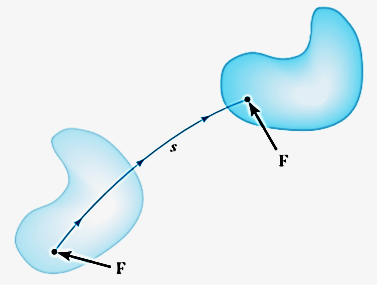
If an external constant force FC (constant in magnitude FC and direction  ) acts on a body to move the body along the path s with translation displacement s, then the work done is given by integrating above equation.
) acts on a body to move the body along the path s with translation displacement s, then the work done is given by integrating above equation.
Hence,


The weight W of a body does work when the center of mass G of a body undergoes a vertical displacement  .
.

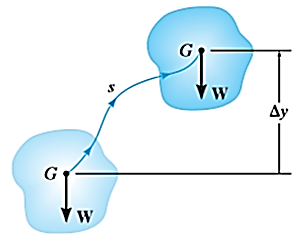
If a linear elastic spring is attached to a body, the spring force  acting on the body does work when the spring either stretches or compresses from
acting on the body does work when the spring either stretches or compresses from  to a further position
to a further position  . In both cases the work will be negative since the displacement of the body is in the opposite direction to the force. The work is given by,
. In both cases the work will be negative since the displacement of the body is in the opposite direction to the force. The work is given by,

There are some external forces that do no work when the body is displaced. These forces act either at fixed points on the body, or they have a direction perpendicular to their displacement. Examples include the reactions at a pin support about which a body rotates, the normal reaction acting on a body that moves along a fixed surface, and the weight of a body when the center of gravity of the body moves in a horizontal plane.

Work by a couple moment for a rigid body
Consider the body shown in Fig a, which is subjected to a couple moment  that displaces the body through an angular displacement of
that displaces the body through an angular displacement of  about an arbitrary point O.
about an arbitrary point O.

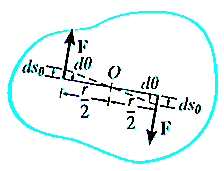
Then each force undergoes a displacement of  in the direction of the force.
in the direction of the force.
Hence work done is given by


When the body rotates in the plane through a finite angle  measured in radians, from
measured in radians, from  to
to  , the work of a couple moment is therefore given by
, the work of a couple moment is therefore given by

If the couple moment has constant magnitude, then

Principle of Work and Energy
By applying principle of work and energy to all the particles of the rigid body and adding all the results algebraically as energy is a scalar quantity, we get

Where,
 is work done by all the external forces and couple moments acting on the body
is work done by all the external forces and couple moments acting on the body
 is the body’s total initial translational and rotational kinetic energy.
is the body’s total initial translational and rotational kinetic energy.
 is the body’s total final translational and rotational kinetic energy.
is the body’s total final translational and rotational kinetic energy.
Consider the rigid body (or slab) shown in Figure, which is constrained to rotate in the vertical plane about a fixed axis perpendicular to the page and passing through the pin at O.
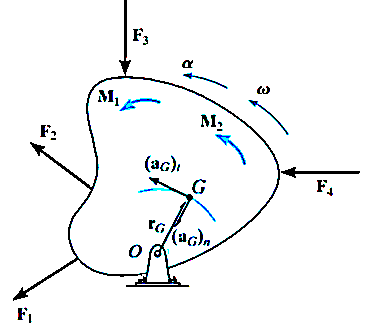
The angular velocity and angular acceleration are caused by the external force and couple moment system acting on the body. Because the body’s center of mass G moves around a circular path, the acceleration of this point is best represented by its tangential and normal components. The tangential component of acceleration has a magnitude of

It must act in a direction which is consistent with the body’s angular acceleration  .
.
The magnitude of the normal component of acceleration is

This component is always directed from point G to O, regardless of the rotational sense of  .
.
The free-body and kinetic diagrams for the body are shown in Fig (a) and (b) respectively below.
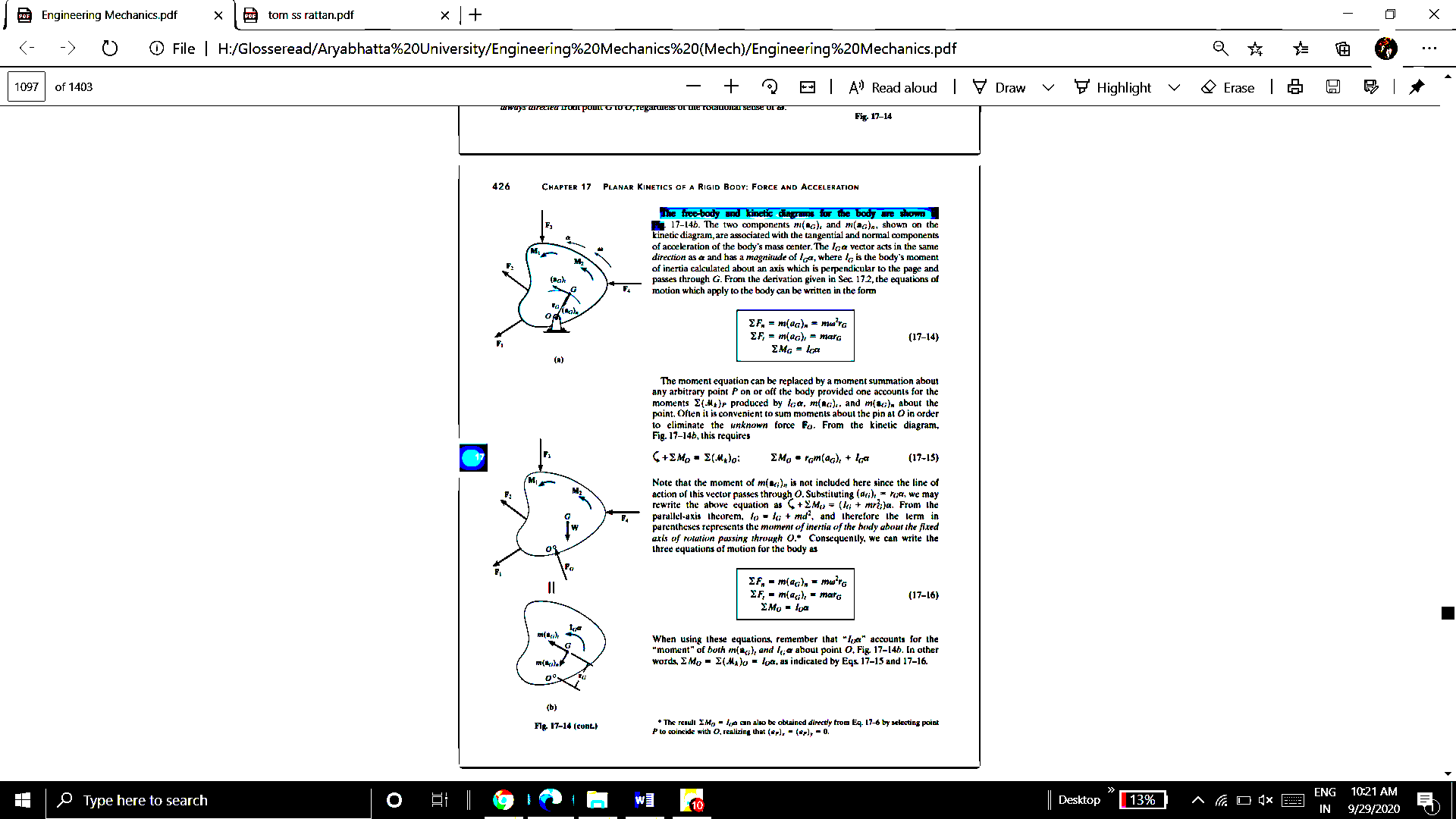
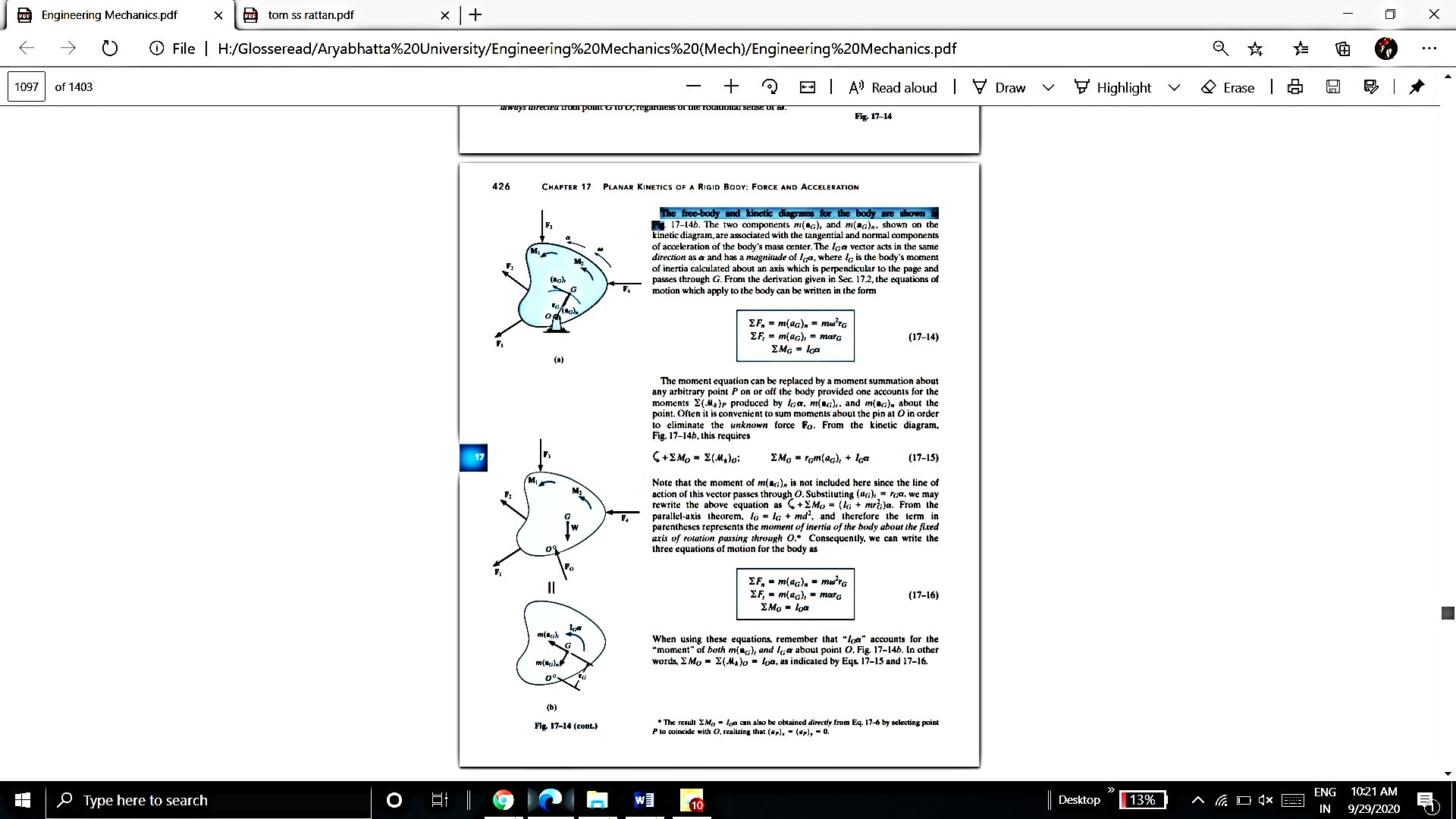
The two components  and
and  shown on the kinetic diagram, are associated with the tangential and normal components of acceleration of the body’s mass center.
shown on the kinetic diagram, are associated with the tangential and normal components of acceleration of the body’s mass center.
The vector  acts in the same direction as
acts in the same direction as  , where
, where  is the body’s moment of inertia calculated about an axis which is perpendicular to the page and passes through G. The equations of motion which apply to the body can be written in the form
is the body’s moment of inertia calculated about an axis which is perpendicular to the page and passes through G. The equations of motion which apply to the body can be written in the form



If the body rotates about an axis perpendicular to plane of body and passing through point O which is at a distance of d from CG. Then the equations of motion which apply to the body can be written in the form



Where, 
References:
1. Irving H. Shames (2006), Engineering Mechanics, 4th Edition, Prentice Hall
2. F. P. Beer and E. R. Johnston (2011), Vector Mechanics for Engineers, Vol I - Statics, Vol II, – Dynamics, 9th Ed, Tata McGraw Hill
3. R. C. Hibbler (2006), Engineering Mechanics: Principles of Statics and Dynamics, Pearson Press.
4. Andy Ruina and Rudra Pratap (2011), Introduction to Statics and Dynamics, Oxford University Press
5. Shanes and Rao (2006), Engineering Mechanics, Pearson Education

